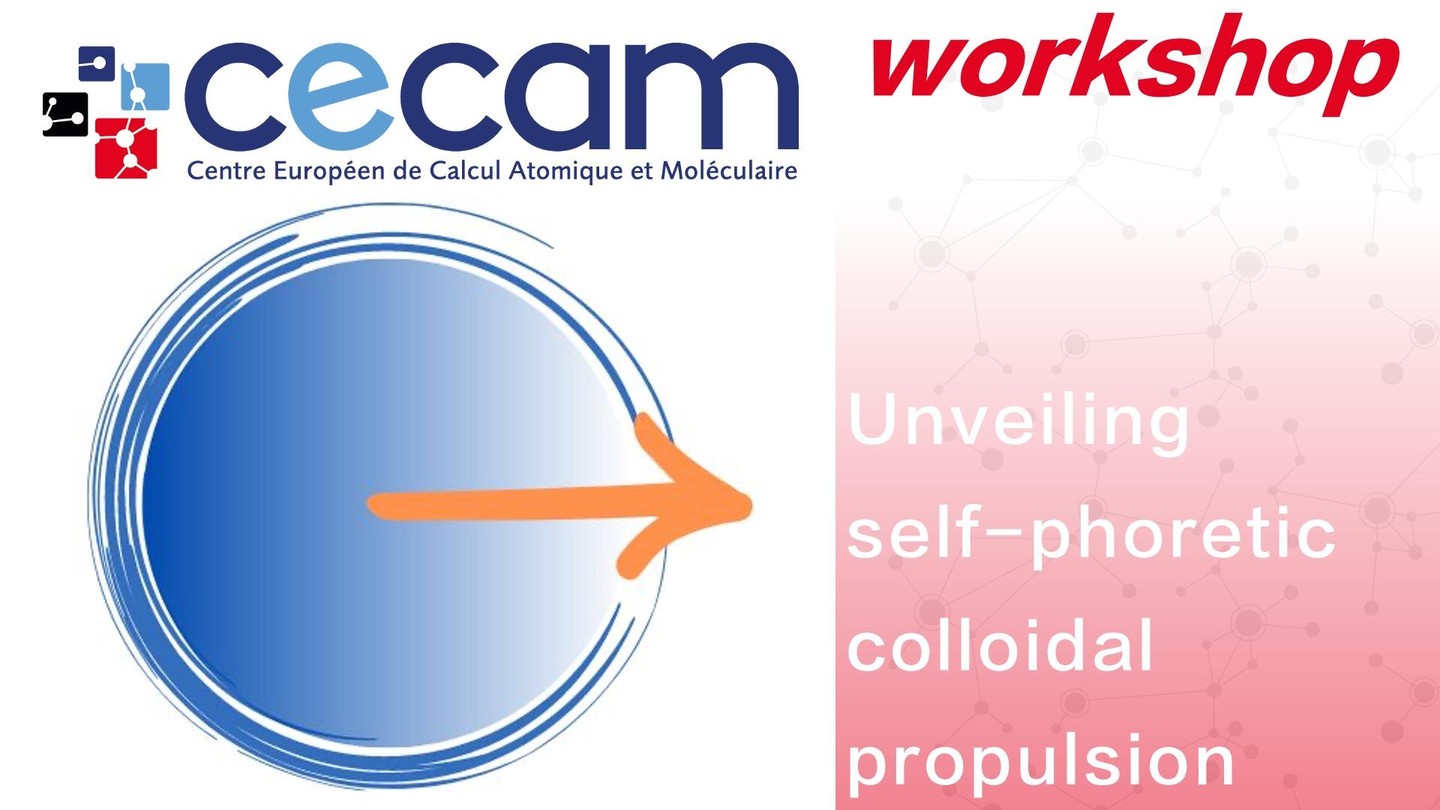Unveiling self-phoretic colloidal propulsion

Event details
| Date | 03.12.2025 › 05.12.2025 |
| Location | |
| Category | Conferences - Seminars |
| Event Language | English |
You can apply to participate and find all the relevant information (speakers, abstracts, program,...) on the event website: https://www.cecam.org/workshop-details/unveiling-self-phoretic-colloidal-propulsion-1378.
Registration is required to attend the full event, take part in the social activities and present a poster at the poster session (if any). However, the EPFL community is welcome to attend specific lectures without registration if the topic is of interest to their research. Do not hesitate to contact the CECAM Event Manager if you have any question.
Description
Phoretic transport refers to the propulsion of colloidal particles driven by local gradients of scalar fields such as solute concentration, electrostatic field, or temperature. When the particle itself is capable of generating such gradients we speak of self-phoretic colloidal transport. This phenomenon has sparked significant research efforts in recent years to understand its fundamental mechanisms and implications through theory, simulations and experiments. In addition, applied research on micro/nanorobots has experienced important progress in view of the possible applications in a range of technologies (e.g. drug delivery systems).
Phoretic —and self-phoretic— transport of colloids is generally understood from a hydrodynamic perspective as driven by interfacial tangential flows originated by the interaction of the particle’s surface and the surrounding liquid within a very thin layer. To understand the underlying mechanisms of transport in the different kinds of self-phoresis and deepen the hydrodynamic description, extensive numerical work has been performed. A variety of simulation techniques have been employed to investigate through a range of time and lengthscales the effects of local gradients on colloidal self-propulsion. These include simulation methods such as Brownian Dynamics, Stokesian Dynamics, Multi-Particle Collision Dynamics, Lattice-Boltzmann, Dissipative Particle dynamics, or Molecular Dynamics. As a result of these investigations evidence has accumulated showing that propulsion in self-phoretic systems can be influenced and perhaps dominated by a competition of physico-chemical effects. For example, propulsion due to the flow field caused by a sudden localized volume expansion in the fluid or by osmotic pressure gradients have been recently discussed. Other well-known results showed that direct solvent-colloid momentum transfer in asymmetric exothermic chemical reactions can be a source of self-propulsion. Morevoer, the surface properties can completely change the reaction pathways taken place on them and be also key to determine the dominant phoretic mechanism. Recent investigations revealed the importance of Marangoni stresses on self-propulsion of colloids at liquid-liquid interfaces. In addition, research was done to reduce self-phoretic particles to the nanoscale, a challenge in the field. In this regime, the mechanisms which originate local field gradients should be different from those of microparticles, and the understanding of propulsion might be influenced by the molecular nature of the solvent.
A detailed description of self-phoretic propulsion and of the fields involved (hydrodynamic flow, but also the solute concentration, temperature or electrostatic field) is also important to determine the nature of the mutual interactions between self-phoretic particles. The interplay of these fields at different scales –from the nano to the mesoscale–, plays a determinant role in the emergence of collective behavior in suspensions of self-phoretic agents. This point is crucial to understand dense systems of self-propelling particles, known to exhibit a very rich phenomenology including out-of-equilibrium phase transitions.
At this point, and despite the advances made, we lack a clear unifying picture of the different effects which contribute to transport in self-phoretic systems. Without that description, a realistic account of interactions between self-phoretic agents is not possible. In this context, exchanging ideas and brainstorming new ones on self-phoresis from different perspectives and scales is thus a crucial and timely topic at the leading edge of research, and one that would benefit from in-depth discussion. This is the aim of the workshop.
References
[1] J. Anderson, Annu. Rev. Fluid Mech., 21, 61-99 (1989)
[2] R. Golestanian, T. Liverpool, A. Ajdari, New J. Phys., 9, 126-126 (2007)
[3] C. Bechinger, R. Di Leonardo, H. Löwen, C. Reichhardt, G. Volpe, G. Volpe, Rev. Mod. Phys., 88, 045006 (2016)
[4] J. Moran, J. Posner, Annu. Rev. Fluid Mech., 49, 511-540 (2017)
[5] G. Gompper, R. Winkler, T. Speck, A. Solon, C. Nardini, F. Peruani, H. Löwen, R. Golestanian, U. Kaupp, L. Alvarez, T. Kiørboe, E. Lauga, W. Poon, A. DeSimone, S. Muiños-Landin, A. Fischer, N. Söker, F. Cichos, R. Kapral, P. Gaspard, M. Ripoll, F. Sagues, A. Doostmohammadi, J. Yeomans, I. Aranson, C. Bechinger, H. Stark, C. Hemelrijk, F. Nedelec, T. Sarkar, T. Aryaksama, M. Lacroix, G. Duclos, V. Yashunsky, P. Silberzan, M. Arroyo, S. Kale, J. Phys.: Condens. Matter, 32, 193001 (2020)
[6] F. Sagués Mestre, Colloidal Active Matter, 2022
[7] S. Eloul, W. Poon, O. Farago, D. Frenkel, Phys. Rev. Lett., 124, 188001 (2020)
[8] M. De Corato, X. Arqué, T. Patiño, M. Arroyo, S. Sánchez, I. Pagonabarraga, Phys. Rev. Lett., 124, 108001 (2020)
[9] G. Elfring, J. Brady, J. Fluid Mech., 952, A19 (2022)
[10] C. Calero, E. Sibert III, R. Rey, Nanoscale, 12, 7557-7562 (2020)
[11] J. Palacci, S. Sacanna, A. Steinberg, D. Pine, P. Chaikin, Science, 339, 936-940 (2013)
[12] K. Dietrich, N. Jaensson, I. Buttinoni, G. Volpe, L. Isa, Phys. Rev. Lett., 125, 098001 (2020)
[13] A. Solon, J. Stenhammar, R. Wittkowski, M. Kardar, Y. Kafri, M. Cates, J. Tailleur, Phys. Rev. Lett., 114, 198301 (2015)
[14] K. Zhang, J. Fraxedas, B. Sepulveda, and M. J. Esplandiu, ACS Appl. Mater. Interfaces, 9, 51, 44948 (2017)
Practical information
- Informed public
- Registration required
Organizer
- Carles Calero, Universitat de Barcelona ; Maria Jose Esplandiu, Catalan Institute of Nanscience and Nanotechnology ; Ignacio Pagonabarraga, University of Barcelona
Contact
- Cornelia Bujenita, CECAM Events and Operations Manager